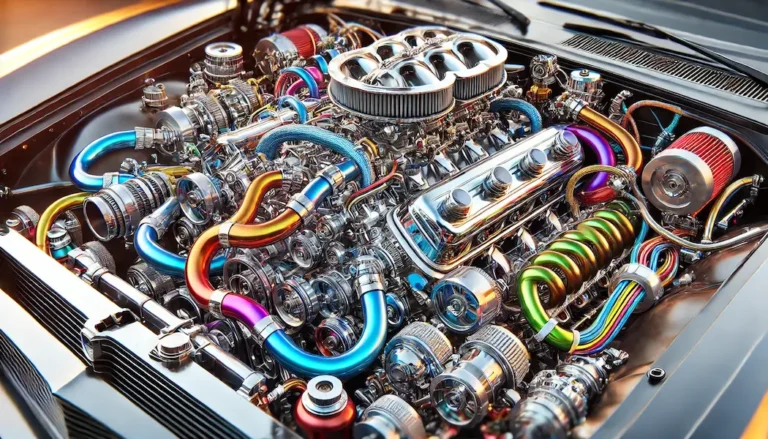Cars with N54 Engine: BMW’s Twin-Turbo Legacy

Key Takeaways
- N54 Engine Significance: A pioneering twin-turbocharged inline-six engine that set new performance standards in the automotive industry.
- Key BMW Models: Notable vehicles like the BMW 135i, 335i, and 535i were powered by the N54, offering a blend of power and refinement.
- Technical Excellence: The N54 engine was celebrated for its advanced turbocharging technology, robust power output, and exceptional tunability.
- N54 vs. N55: The N54 was succeeded by the N55, which offered single-turbo efficiency but faced comparisons in terms of reliability and performance.
- Common Issues: Owners should be aware of potential issues like High-Pressure Fuel Pump (HPFP) failures and turbocharger problems.
- Tuning Potential: The N54 engine remains popular in the tuning community, with substantial aftermarket support for performance enhancements.
Introduction to the N54 Engine
When BMW introduced the N54 engine in 2006, it wasn’t just another engine—it was a game-changer. I remember the buzz around its release, the way it redefined what enthusiasts like myself could expect from a turbocharged inline-six. The N54 engine, a 3.0-liter twin-turbocharged inline-six, showcased BMW’s engineering prowess, pushing the boundaries of what a performance engine could be. It’s no surprise that this engine quickly became a favorite among driving enthusiasts and tuners alike. This wasn’t just about power and speed; it was about the joy of driving, and that’s something the N54 delivered in spades.
History and Development of the N54 Engine
BMW wasn’t just meeting market demands when they developed the N54; they were responding to a challenge—how to give us thrill-seekers the power we craved without sacrificing efficiency. And, if you ask me, they nailed it. Introduced initially in the 2007 BMW 335i, the N54 was BMW’s first mass-production engine to feature twin turbochargers. The engine was designed to deliver V8-like performance from a more compact and lighter inline-six platform. Over the years, BMW refined the N54, using it in a variety of models across their lineup, from sedans to SUVs, until it was gradually replaced by the N55 engine in 2010.
Technical Specifications of the N54 Engine
Let’s dive into the specs that make the N54 tick—and why they still get me excited every time I pop the hood. The N54’s specs were more than just numbers on a page for me—they were a promise of the thrilling drives to come. The twin-turbo setup, in particular, always stood out as a masterstroke of engineering. Below is a detailed breakdown of its technical specifications:
| Specification | Details |
|---|---|
| Engine Configuration | Inline-6, DOHC |
| Displacement | 3.0 liters (2,979 cc) |
| Turbochargers | Twin-turbo, parallel configuration |
| Maximum Power Output | 300 hp (225 kW) at 5,800 rpm |
| Maximum Torque | 300 lb-ft (407 Nm) from 1,400 to 5,000 rpm |
| Compression Ratio | 10.2:1 |
| Fuel Injection | Direct injection |
| Fuel Efficiency | Combined ~24 mpg (varies by model) |
| Emissions Standards | Euro 5 compliant |
Key BMW Models Featuring the N54 Engine
The N54 wasn’t just another engine to me—it was the soul of some of BMW’s most thrilling rides. These cars didn’t just impress—they left an imprint. Here are a few models that captured the essence of what made the N54 so special:
BMW 135i
Driving the BMW 135i for the first time felt like meeting a new best friend—instantly comfortable, but with a hint of wildness waiting to be unleashed. The N54 engine transformed this compact sports car into a truly memorable ride. Introduced in 2008, the 135i was the performance variant of the 1 Series. Its agile handling, combined with the robust output of the N54, made it a favorite among enthusiasts looking for a small, yet potent, sports car.
BMW 335i
The BMW 335i was arguably the most iconic model to feature the N54 engine. It offered a perfect balance between everyday usability and high-performance driving. Available in sedan, coupe, and convertible forms, the 335i was versatile and well-received by both critics and consumers. The engine’s ability to deliver consistent power across a broad rpm range was a standout feature, making it one of my personal favorites.
BMW 535i
The BMW 535i, part of the 5 Series lineup, combined the luxury and comfort expected from a BMW sedan with the performance capabilities of the N54 engine. This model provided a refined yet spirited driving experience, making it popular among those who wanted both luxury and speed. The 535i was always a car I admired for its ability to offer the best of both worlds.
BMW Z4 (E89)
The BMW Z4, specifically the E89 generation, featured the N54 engine in its sDrive35i variant. This roadster was known for its stylish design and exhilarating open-top driving experience. The N54’s power delivery made the Z4 a joy to drive on winding roads and highways alike. For anyone who loves the idea of a top-down, wind-in-your-hair experience with the power to back it up, the Z4 was a dream.
BMW X6 xDrive35i
The BMW X6 xDrive35i was one of the first crossovers to be equipped with the N54 engine. Despite its larger size, the X6 offered impressive acceleration and handling, thanks in part to the engine’s potent twin-turbo setup. This model demonstrated the versatility of the N54 engine across different vehicle types. I was initially skeptical about a performance-oriented SUV, but the X6 with the N54 proved to be a surprising delight.
N54 vs. N55 Engine: A Comparison
While the N55 brought some welcome efficiency improvements, I always found the N54’s twin-turbo setup more engaging. There’s something about the way it delivers power that makes it feel like the engine is alive, constantly eager to deliver that next surge of acceleration. Here’s how the two engines compare:
| Feature | N54 Engine | N55 Engine |
|---|---|---|
| Turbochargers | Twin-turbo | Single-turbo (twin-scroll) |
| Maximum Power Output | 300 hp | 300 hp |
| Torque | 300 lb-ft | 295 lb-ft |
| Tuning Potential | High (up to 600+ hp possible) | Moderate (up to 500+ hp) |
| Reliability | Known issues (e.g., HPFP) | Improved reliability |
| Fuel Efficiency | Moderate | Improved |
Performance Capabilities of the N54 Engine
The N54 isn’t just about raw numbers—though they’re impressive. It’s about that grin you can’t wipe off your face after a drive, the way it connects with you on the road. It’s the kind of engine that leaves a lasting impression long after you’ve parked. Here are some key performance metrics:
- 0-60 mph: Around 5 seconds (varies by model).
- Top Speed: Electronically limited to 155 mph.
- Quarter Mile: Approximately 13 seconds.
- Tunability: Capable of reaching over 600 hp with aftermarket modifications, including upgraded turbos and ECU remapping.
I’ve seen firsthand how easily the N54 responds to tuning, making it a favorite among those looking to extract every ounce of performance from their BMW.
Reliability and Common Issues with the N54
Now, I’d be lying if I said the N54 was flawless—far from it. I’ve had my fair share of battles with HPFP issues, and I know many who’ve had similar stories. Here’s what you need to watch out for:
- High-Pressure Fuel Pump (HPFP) Failures: A frequent problem leading to hard starts, stalling, and reduced performance. BMW issued several recalls and extended warranties to address this.
- Turbocharger Wastegate Rattle: Over time, the wastegate actuators can wear out, causing a rattling noise and potential boost issues.
- Carbon Buildup: Direct injection engines like the N54 are prone to carbon buildup on the intake valves, which can lead to reduced performance and rough idling.
To mitigate these issues, regular maintenance is crucial. This includes timely oil changes, using high-quality fuel, and periodically cleaning the intake system. Trust me, if you want your N54 to run like the day you got it, regular maintenance isn’t just a suggestion—it’s a must.
Tuning and Aftermarket Support for the N54
Tuning the N54 isn’t just about squeezing out more power—it’s about making the car truly yours. Every mod is like a signature, transforming a great engine into something extraordinary. The N54 engine is highly regarded in the tuning community due to its robust construction and significant aftermarket support. Enthusiasts often achieve power levels exceeding 600 horsepower with modifications, making the N54 a favorite for those seeking extreme performance. Some of the popular tuning options include:
- Turbo Upgrades: Replacing the stock turbos with larger ones can dramatically increase power output.
- ECU Remapping: Optimizing the engine’s electronic control unit (ECU) can unlock additional power and improve throttle response.
- Intercooler Upgrades: Larger intercoolers help manage heat, allowing for more consistent performance during extended hard driving.
- Exhaust Systems: High-flow exhausts reduce backpressure, enhancing both performance and sound.
These modifications are more than just upgrades—they’re a way to personalize and enhance the driving experience, turning a great engine into an extraordinary one.
N54 Engine in Motorsport
The N54 engine has seen use in various motorsport applications, particularly in time attack and endurance racing. Its ability to produce significant power reliably has made it a popular choice among privateers and tuning shops. Notable achievements include competitive lap times in time attack events and impressive endurance performance in long-distance races, solidifying the N54’s reputation as a versatile and capable powerplant.
Owner Experiences and Reviews
The BMW N54 community is active and passionate, with many owners praising the engine for its blend of performance and tunability. I’ve spent countless hours on forums and at car meets, hearing firsthand the love and frustration this engine inspires. Common themes in reviews include:
- Driving Experience: Owners often highlight the smooth power delivery and strong mid-range torque.
- Maintenance Concerns: While the engine is loved for its performance, many acknowledge the need for vigilant maintenance to avoid common issues.
- Tuning Potential: The N54 is frequently cited as one of the most tunable engines, with a wide array of aftermarket options available.
Long-term owners who maintain their N54-powered vehicles properly often report high satisfaction, despite the engine’s known issues. It’s clear that for many, the joy of driving an N54-powered BMW far outweighs any maintenance headaches.
Case Studies: Iconic Builds with the N54
Several notable builds have showcased the N54 engine’s capabilities. I’ve followed many of these builds closely, often marveling at the ingenuity and dedication involved:
- High-Performance Street Builds: Some enthusiasts have pushed the N54 to over 700 horsepower, creating incredibly fast street cars that retain daily drivability.
- Time Attack Monsters: Tuners have used the N54 to build competitive time attack cars, utilizing its tunability to optimize power delivery for track performance.
- Tuning Garage Case Study: A case study of a prominent BMW tuning garage demonstrates how they extract maximum performance from the N54 while maintaining reliability.
These builds highlight the engine’s versatility and its ability to perform at a high level in various automotive disciplines. For anyone looking to get serious about performance tuning, the N54 is a compelling choice.
Conclusion: The Legacy of the N54 Engine
The N54 isn’t just a chapter in BMW’s history—it’s a story I’ve lived, and one that continues to unfold. For those of us who’ve had the pleasure of driving one, it’s a legacy that’s hard to forget. The N54 engine has left an indelible mark on BMW’s history and the broader automotive world. As BMW’s first mass-produced turbocharged engine, it set new standards for performance and tunability, earning a devoted following among enthusiasts. Despite its challenges, the N54 is celebrated for its engineering excellence and its role in defining a new era of BMW performance. Its legacy continues to influence the design and development of BMW’s modern engines, cementing its place as one of the most significant engines in automotive history.
Frequently Asked Questions (FAQs)
What makes the N54 engine special? The N54’s twin-turbo setup, combined with its smooth power delivery and significant tuning potential, makes it a standout engine in BMW’s lineup.
How does the N54 compare to later BMW engines? The N54 is often compared to its successor, the N55, with many enthusiasts preferring the N54 for its greater tuning potential and twin-turbo configuration.
What should new owners know about maintaining an N54 engine? Regular maintenance is key to keeping the N54 running smoothly. Owners should be aware of common issues like HPFP failures and turbocharger problems and address them proactively.
Are there any known recalls for the N54 engine? Yes, BMW issued several recalls for the N54, primarily related to the HPFP and turbocharger wastegates. Checking the vehicle’s service history for completed recall work is advisable.
What are the best performance upgrades for the N54? Popular upgrades include turbo replacements, ECU remapping, and intercooler enhancements, all of which can significantly increase the engine’s power output.
Thanks for checking out this article on EngineEcho.com! Hope you found this article: "Cars with N54 Engine: BMW’s Twin-Turbo Legacy" helpful! If you liked it and want to dive into more car engine topics, head over to our homepage. There's always something new to discover in the world of engines. Enjoy your reading journey!
Check out our previous article: Cars with Cummins Engine: Durability and Power






